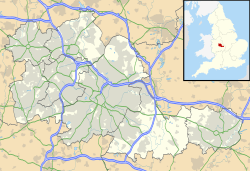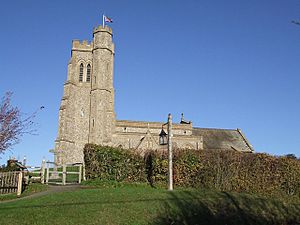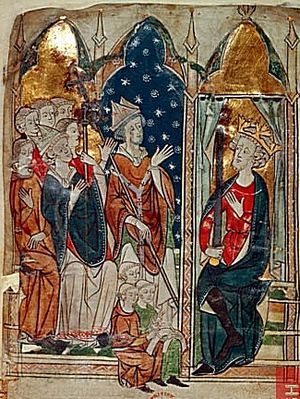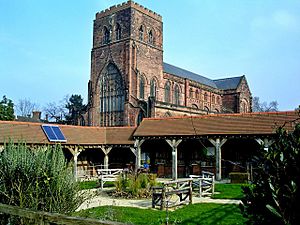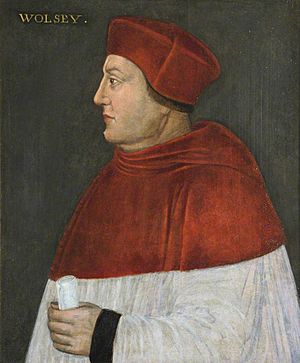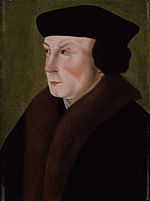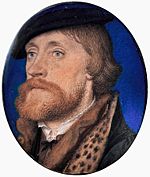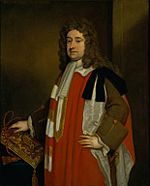Sandwell Priory facts for kids
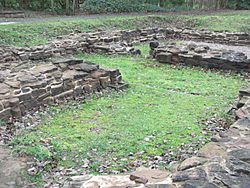
Remains of the south chapels of the priory church.
|
|
| Monastery information | |
|---|---|
| Full name | The Priory of St Mary Magdalene of Sandwell |
| Other names | Communis Sancte Marie Madalena de Sandwelle |
| Order | Benedictine |
| Established | c. 1190 |
| Disestablished | 1525 |
| Dedicated to | Mary Magdalene |
| Diocese | Diocese of Coventry and Lichfield |
| Controlled churches | Ellesborough St Clement's (now All Saints') Church, West Bromwich (farmed from Worcester Priory after 1230) |
| People | |
| Founder(s) | William Fitz Guy of West Bromwich |
| Important associated figures |
|
| Site | |
| Location | Sandwell Valley Country Park |
| Coordinates | 52°31′11″N 1°57′53″W / 52.5198°N 1.9648°W |
| Visible remains | Low walls indicating the plan of the priory church. |
| Official name: Sandwell Priory, a Benedictine monastery | |
| Designated: | 2 July 1974 |
| Reference #: | 1017763 |
| Public access | yes |
Sandwell Priory was a small Benedictine monastery in medieval England. It was located near West Bromwich, which was then part of Staffordshire. A local landowner started the priory in the late 1100s. It never had a lot of money or resources.
The priory had a difficult history, often facing problems with how it was managed. It was closed down in 1525 by Cardinal Wolsey. This happened more than ten years before King Henry VIII closed many other monasteries in England.
Contents
Who Founded Sandwell Priory?
The person who founded Sandwell Priory was William, son of Guy de Offeni. His family owned land in West Bromwich. William was in charge of the land by 1166.
William Fitz Guy was an important tenant of Gervase de Paynel. Gervase held the lordship of Dudley. This means he was the main lord of the area. Gervase's grandfather had married into a powerful family. This family owned a lot of land in the Midlands after the Norman Conquest.
Both Gervase and William were interested in supporting monasteries. Gervase had founded Dudley Priory around the mid-1100s. William's family also gave gifts to Dudley Priory.
It seems there was a hermitage (a place for a hermit) at the site before the priory. It was next to a well, which gave the place its name, Sandwell. But William was the one who properly started the monastery. It was a home for Benedictine monks. They dedicated it to St Mary Magdalene. The priory was likely founded around 1190, but it could have been earlier. Gervase confirmed William's gifts to the priory. This is how we know about its beginnings.
How Did the Priory Get Money and Land?
William gave the monks land by the Sandwell hermitage to build their monastery. This shows that the site was already used for religious purposes. William also gave them part of a church and a house in Ellesborough in Buckinghamshire. Gervase de Paynel also supported this gift.
Other monasteries also replaced older hermitages. For example, Haughmond Abbey in Shropshire was founded in the 1100s. William's family were not very rich landowners. So, even though he gave a lot, the priory did not have many resources at first.
He gave some of his own tenants in West Bromwich to the monks. He also gave them land and resources that are hard to identify today. These included:
- Wavera in Handsworth, possibly a water feature.
- Ruworth, a patch of farmland from the royal forest.
- Duddesrudding, another piece of land.
- Land between Petulf Greene and the main road.
- A well or pit in West Bromwich.
- A watermill at Grete, near Greets Green.
William also gave the monks tithes from his household. This meant a share of their bread, hunting, and even food from their kitchen. He also gave them wood for burning and building. A very important gift was the right to let their animals graze in West Bromwich manor.
The most important gift was a large piece of land on the eastern side of West Bromwich. This land became the main part of the priory's estates. The monks had the right to hold a manorial court. This meant they could manage their lands like other landowners.
The priory's wealth grew slowly over time. The priors (leaders of the priory) often had to fight legal battles to keep their rights. In the 1200s, there were big arguments with the Parles family of Handsworth. These were first about land, then about who controlled the church at Handsworth. The priory lost its share of the church. But it gained a house in Birmingham and rent from a mill in Hamstead.
Another long fight confirmed the priory's right to the church at Ellesborough. Around 1230, Worcester Priory gave Sandwell the church at West Bromwich forever. Sandwell got the church's income. In return, they paid Worcester £4 each year and covered all church costs.
During the time of King Edward I, the priory faced money problems. In 1296, the king took control of church properties. This was because of a dispute with the Pope. The priory had to pay a tax to get its properties back.
After the Black Death in the mid-1300s, land prices dropped. Sandwell Priory bought more property. In 1398, the priory gained full control of its share of Ellesborough church. This meant they could collect tithes. They had to provide a priest for the parish. But this often led to the church building falling apart. The priory used the money for other things.
By the time it closed in 1525, the priory owned:
- A fulling mill (for making cloth) at Fazeley.
- Two watermills at West Bromwich.
- Lands in places like Dudley, Tipton, Great Barr, Harborne, and Wednesbury.
What Did the Priory Buildings Look Like?
The priory buildings were inside a rectangular area. This area had ditches on at least three sides. At first, there were two wooden buildings for the monks. These were next to a stone church. The stone church later became the chancel (the area around the altar). The nave (the main part of the church) was extended later. The wooden buildings were rebuilt in stone within a few decades. They were partly rebuilt again about a century later.
The church faced east. It had a crossing (where the nave and transepts meet). It also had north and south transepts (arms of the church). The chancel had a rounded east end. A rectangular belfry (bell tower) was above the crossing. There were pairs of chapels to both the north and south.
In the 1400s, the church was made smaller. This makes sense because the community of monks was very small. In 1526, the chancel was 41 feet long and 18 feet wide. The nave was 57 feet long and 18 feet wide. So, at its largest, the church was probably over 100 feet (30 meters) long.
The cloister (a covered walkway) and living areas were north of the church. Large, two-story buildings surrounded the cloister. These included the kitchens and storage areas. Besides the main buildings, there was a gatehouse with a guardroom. There was also a large barn, a hayhouse, a kilnhouse, a stable, and a thatched watermill.
North of the buildings were at least two fishponds. A spring to the south supplied water to the priory. This water was used for the kitchens and to flush the reredorter (latrine). It also filled the ponds.
- Remains of Sandwell Priory
-
The outline of the cloister.
-
Remains of the north chapels.
-
The presbytery or chancel, photographed from the west.
Problems and Conflicts at the Priory
Sandwell Priory often had a troubled history. It seemed to lack strong leadership and a lively community. There were serious disagreements within the priory itself. There were also conflicts between the monks and local people. And sometimes, there were disputes with other church groups.
Disputes with the Parles Family
The priory quickly became involved in arguments with the Parles family. These lasted for many decades. In 1211 and 1212, William de Parles sued the prior over land. The Parles family's connection to Handsworth, near the priory, is not fully clear.
William de Parles claimed land in Handsworth through his family. The priory's lawyer was Richard, the founder's son. The prior asked Richard to defend the priory's claim. We don't know the outcome of this case. William de Parles later joined a rebellion against King John. In 1216, his Handsworth lands were taken away.
In 1222, William de Parles gave up his claim to the Sandwell land for £5. This money was given to him by Richard. However, Richard died soon after. His brother William took over, but he also died quickly. In 1224, William de Parles tried to claim half the priory's control. He said he had appointed a prior during King John's reign. The case was put on hold.
William de Parles died by 1227. In 1230, John de Parles claimed half the control of Handsworth church from the priory. The prior gave up his claim. In return, John gave the priory a house in Birmingham. The disputes with the Parles family then stopped for thirty years.
However, in 1260, William de Parles and his men attacked the prior. The prior barely escaped alive. William was known for violence. He later granted the priory an annual rent from his mill at Hamstead.
Poor Management and Decline
In 1324, the new prior, Richard de Eselberg, tried to improve things. He had the support of Roger Northburgh, the Bishop of Coventry and Lichfield. Bishop Northburgh urged the monks to obey the prior. He also criticized a monk for dressing in normal clothes. Around the same time, he officially banned a group of laymen who had been taking the priory's property. In 1339, a letter from the Pope mentioned a monk who had left the priory and wanted to return.
Sometimes, the priors themselves caused trouble. In 1341, Prior Richard le Warde got involved in a dispute at Tettenhall. This was about a church college there. The king, Edward III, had forbidden actions against a certain appointment. But Prior Richard and his chaplain were accused of planning to go against the king's orders. They were ordered to be arrested. What happened to their case is unknown. But the king eventually got his way.
The Black Death in 1349 hit the priory hard. When Prior Richard le Warde died, Nicholas de Cumpton was the only other monk. So, he had to become the new prior. In 1354, Bishop Northburgh criticized the priory's poor management. They had neglected their woodlands and fences. They also leased land for too long. In 1361, when Prior William del Ree died, there was again only one other monk, Henry of Kidderminster. He became the new prior.
Shrewsbury Abbey's Influence
The priory's weakness encouraged Shrewsbury Abbey to try and take it over. Around 1370, the Abbot of Shrewsbury, Nicholas Stevens, supported someone named Richard Tudenham. Tudenham claimed to be the rightful prior instead of the current one, John de Kyngeston. Kyngeston took legal action against those who attacked him. One man, John de Witton, even wounded him with an arrow. Witton tried to argue that Kyngeston wasn't the real prior.
In 1379, Kyngeston made more serious claims against Abbot Stevens. Kyngeston said Stevens and other monks from Shrewsbury Abbey attacked him at the priory. They took him to a house in Sleap. There, he was forced to sign a resignation letter. He also had to stop all legal actions against Stevens.
Despite these claims of force, Bishop Robert de Stretton accepted the prior's resignation. He received letters saying the two remaining monks had elected Richard de Westbury as their prior. The bishop confirmed Westbury. But Westbury was then challenged by Tudenham, who had tried to become prior before. Tudenham got approval from the Pope. But King Richard II's Council ordered his arrest. This was because he broke a law against papal appointments.
Westbury also had problems with the priory's patrons (the families who supported it). In 1387, John Marnham sued Westbury. This showed how bad the relationship was between the priory and its supporters.
In 1391, when it was time to elect Westbury's successor, there was only one monk left. He elected William Pontesbury, a monk from Shrewsbury. But the new bishop, Richard le Scrope, cancelled this choice. He brought in John of Tamworth from Coventry as prior. This was one of several times a bishop overturned a prior's election.
However, the struggle continued. In 1397, a monk named Alexander Leddesham, with an armed group, drove Tamworth out. Leddesham took his place for a while. Tamworth went to court to get his position back.
Abbot Stevens died in 1399. This might have made it easier to accept a prior from Shrewsbury. In 1401, Archbishop Thomas Arundel appointed John de Acton, a monk from Shrewsbury, as Tamworth's successor. His successor, Richard Dudley, was accused of helping criminals in 1414. He was said to have welcomed robbers at the priory. Dudley was later pardoned.
The Priory Closes Down
Cardinal Thomas Wolsey did not have much respect for monasteries. When he became Lord Chancellor in 1515, he asked the Pope for permission to inspect all monasteries in England. He got it in 1518. In 1524, Wolsey was very powerful. He decided to start a new college for Oxford University. It was to be called Cardinal College.
To pay for this, he planned to close down the Priory of St Frideswide in Oxford and other monasteries. In September 1524, Pope Clement VII approved Wolsey's plan. This allowed him to take over monasteries worth up to 3000 ducats.
Sandwell was an easy target. It had a long history of problems and conflicts. It also had a very small community, just the prior and one monk. Sandwell and Canwell Priory were chosen as suitable for Wolsey's plan. This was on a list of 22 monasteries. The list was made by Thomas Wriothesley, who worked for Wolsey. On October 1, the king agreed for Wolsey to close Sandwell.
The official document for closing Sandwell was signed on February 4, 1525. Prior John Baylye and the other monk were moved to different Benedictine monasteries. The king gave the properties of Sandwell and other closed monasteries to Wolsey in 1526. Wolsey then gave them to John Hygdon, the dean of Cardinal College.
A full survey of all the monastery properties was done in 1527. Sandwell Priory and its properties were valued at less than £40 a year. This included income from tithes and rents. Higdon tried to get more money from the estates. He visited Sandwell to raise rents. Wolsey kept some control of the church at West Bromwich. In 1528, Thomas Cromwell tried to replace the priest there with the former monk from the priory. For a time, two priests fought over who would say Mass in the church.
What Happened After the Priory Closed?
When Wolsey was accused of crimes in 1529, the future of Sandwell and other closed monasteries became unclear. The properties went back to the Crown (the king). They were not always given to the new college, King's College (which became Christ Church, Oxford).
Local landowners were asked to investigate the properties. In Staffordshire, these included Sir John Giffard and Edward Littleton. After this, William Burbank and Thomas Cromwell visited Sandwell in 1530. They sold off valuable items and raised £21. The bells of Sandwell were valued at £33 6s. 8d. Many of Sandwell's estates went to the new college. But the Ellesborough estates went to other religious places.
The manor of Sandwell was a useful asset for the king, who often needed money. It was given to Dame Lucy Clifford. When she died in 1557, it passed to her grandson, John Cutte. He later sold it to the Whorwood family. During the 1500s, some of the priory buildings were made into a comfortable private home, called Priory House. The church was still mostly standing in 1588. But it was torn down soon after.
After the English Civil War and financial problems, the Whorwoods sold Sandwell in 1701. It was bought by William Legge, 2nd Baron Dartmouth. He later became the 1st Earl of Dartmouth. Sandwell Park became an important estate for the Earls of Dartmouth. By 1845, they owned over 2000 acres in the area. A large new Georgian house was built next to the priory site. It even used some of the priory's old foundations and stones.
However, the earls later moved to another home. Parts of the Sandwell estate were sold for housing. In 1947, West Bromwich council bought 1,367 acres. They wanted to keep a large area of open country for the townspeople to enjoy.
Sandwell Priory Today
Today, the site of Sandwell Priory is inside Sandwell Valley Country Park. It is also part of the Priory Woods Local Nature Reserve. This area is in modern West Bromwich. The Sandwell Metropolitan Borough Council manages it. The council and park are named after the priory.
Very little of the priory remains. But its original layout has been marked out. The plan of the church is quite clear. There are some low stone walls from the structure. There are also the remains of an open stone grave. The site is next to a footpath. It is open to the public for free at all times. It is a scheduled monument, which means it is protected.
A small museum in the country park's visitor center has exhibits about the priory.


